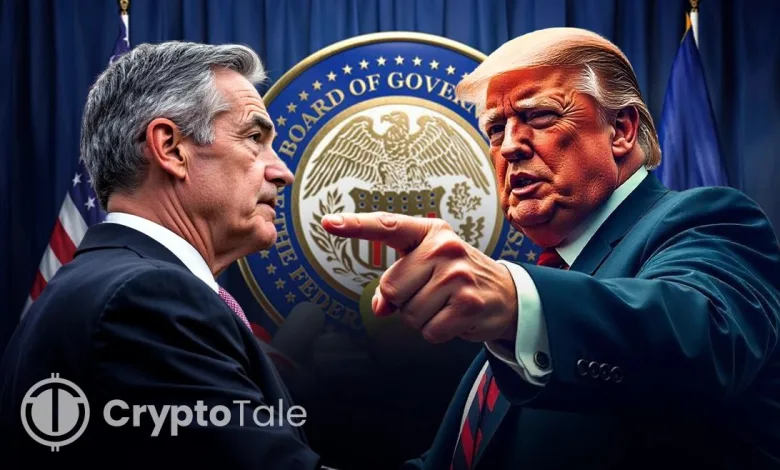Bitcoin Hits $115K in Selloff Linked to Trump-Powell Meeting

- Bitcoin fell to $115K as over $675 million in trades were liquidated in just one day.
- President Trump met Powell and urged a rate cut while also attacking the Fed’s spending.
- CoinGlass showed heavy BTC sell zones that formed near $118K and $115K during the crash.
A fierce sell-off wiped out over $675 million in leveraged crypto positions within 24 hours, triggering widespread liquidations across major tokens. This came as Bitcoin fell sharply to $115,000, and over $105 million in long positions were erased in one hour. Altcoins followed suit, marking synchronized losses across the board as panic spread across crypto exchanges and investor sentiment rapidly weakened. The timing raised a critical question: Did President Trump’s public confrontation with Fed Chair Powell ignite macro fears behind the crash?
Major Tokens See Sharp Declines
Bitcoin dropped 2.65% to $115,394.80, falling from a high of $119,500, while Ethereum lost 1.71%, settling at $3,578.65. Solana plummeted 7.53% to $175.66, and BNB declined 3.41% to $753.83. Further, XRP, which was trading at 4.60% had lowered to $3.0466.
Apart from top tokens, smaller assets posted heavier losses. Dogecoin plunged 8.50% to $0.2224, ADA slipped 4.07% to $0.7834, and DOT dropped 6.73% to $3.8650. While most coins fell, TRX gained 0.32%, reaching $0.3116, and BCH rose 0.10%, closing at $515.99.
Losses continued across LINK, LTC, SUI, APT, EGLD, OP, NEAR, XLM, and AAVE. Most assets declined between 3% and 8%, confirming the broad market fallout. As leveraged trades failed, exchanges reported cascading liquidations across positions.
Analysts attributed the event to a combination of technical breakdowns, weak support levels, and overexposure to leverage across key assets. Margin calls intensified rapidly once BTC broke $117,000, dragging other tokens down in tandem.
Trump Presses Powell on Rate Cuts
On July 24, 2025, President Donald Trump visited the Fed Chair Jerome Powell at the Federal Reserve office. The visit garnered attention as this was the first visit by a sitting President in two decades. Trump criticized Powell for the central bank’s $2.5 billion renovation plan, claiming the cost rose to $3.1 billion.
Trump urged Powell to cut interest rates, saying borrowing costs were too high for households. Powell maintained that rates would likely stay between 4.25% and 4.50%, defending the Fed’s independence during a public exchange.
Trump also stated he had no current plans to fire Powell, though earlier in the week, he called the Chair a “numbskull.” The visit sparked political debate, with Republican lawmakers questioning the Fed’s financial transparency and project budgeting.
Tensions surrounding monetary policy stoked investor unease. The visit’s timing, hours before the crypto collapse, raised speculation that markets reacted to policy uncertainty and potential interference with Fed decisions.
Data Reveals High-Density Liquidation Zones
CoinGlass data showed Bitcoin’s price collapsed from near $120,000 to around $115,000 between 01:00 and 07:35 UTC today. Liquidation heatmaps exposed thick layers of leverage concentrated around $118,000, $117,000, and $115,000.
Source: Coinglass
Such groups caused the sell-offs when BTC breached major supports. According to CoinGlass, the highest the liquidation leverage recorded was at the sum of $120.42 million, meaning that people were deleveraging aggressively.
At this window, various sales zones were created. The efforts to drive BTC higher towards the $118,000 level were unsuccessful because these liquidation walls prevented any attempt at going to the upside. The next few bands of forced liquidations drove prices down between 24.19 and 06.20 UTC.
Related: FBI Ends Probe Against Kraken Co-Founder Powell, Returns Seized Devices
The heatmap data shows how the leverage traders got pushed out at every breakdown, which added to the losses in the market. This is not only a sign of technical weakness but also increasing macro fear, according to analysts. As the political environment becomes more uncertain and the Fed is under criticism, the market participants wonder how the policy friction can further shape high-risk assets.




